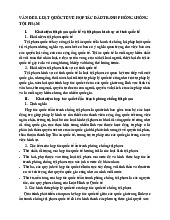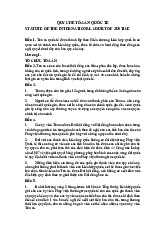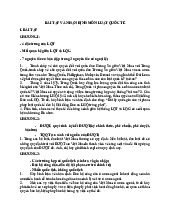










Preview text:
lOMoAR cPSD| 45734214 JUSTICE MINISTRY HANOI LAW UNIVERSITY GROUP ASSIGNMENT
PUBLIC INTERNATIONAL LAW
Topic: Analyze the modes of legal acquisition of
territory in international law. Refer to the
practice of some states
L Ớ P: N02-TL04 NHÓM: 03 lOMoAR cPSD| 45734214
TEAMWORK QUALITY ASSESSMENT TABLE 1. Work assignment table Student’s number Members Task 463037 Nguyễn Bảo Trang
Word + The modes of legal acquisition of Leader
territory in International Law 463034 Phạm Đỗ Minh Quân International Practices on Territorial Acquisition 463035 Đỗ Thị Thanh Tâm
The modes of legal acquisition of territory in International Law 463039 Nguyễn Thị Kim Vân
International Practices on Territorial Acquisition 463040 Hoàng Hà Vy Overview 463041 Trần Châu Anh
Powerpoint + Conclusion + Introduction
2. Evaluation of teamwork results Participating Article Submission Members attitude quality time Rating Nguyễn Bảo Trang Positive Good On time A Phạm Đỗ Minh Quân Positive Good On time A Đỗ Thị Thanh Tâm Positive Good On time A Nguyễn Thị Kim Vân Positive Good On time A Hoàng Hà Vy Positive Good On time A Trần Châu Anh Positive Good On time A TABLE OF CONTENT
INTRODUCTION ................................................................................................ 3
CONTENT ............................................................................................................. 4
I. Overview ............................................................................................................ 4
1. National territory ................................................................................................ 4
2. Legal acquisition of territory .............................................................................. 5
II. The modes of legal acquisition of territory in International Law .............. 5 lOMoAR cPSD| 45734214
1. Occupation .......................................................................................................... 5
2. Accretion ............................................................................................................. 5
3. Cession ................................................................................................................ 6
4. Conquest ............................................................................................................. 7
5. Prescription ........................................................................................................ 8
III. International Practices on Territorial Acquisition ..................................... 8
1. Island of Palmas Case ........................................................................................ 8
2. Alaska Pacific Fisheries v. United States ......................................................... 10
CONCLUSION ................................................................................................... 11
REFERENCE MATERIAL ............................................................................... 11 INTRODUCTION
International Law is based on the concept of the State. No State can exist without
territory. International disputes pertaining to land title as well as the precise determination
of State boundaries, are the subject of international proceedings. As you know, the
international community comprises States, and the existence of the States are defined by
their territory and sovereignty. The sovereignty sits at the heart of International Law. The
title to territory is based on sovereignty. State exercises its supreme authority within its
territory. The territorial sovereignty enables a State to exercise its fullest measure of
sovereignty powers over its land territory. In order to function as a State, the State must
possess territory. However, there are territories over which there is no sovereign.
So how can an entity acquire its own territory in international law while under
classical international law, until a new state is created, there is no legal person in existence
competent to hold title. None of the traditional modes of acquisition of territorial title
satisfactorily resolves the dilemma, which has manifested itself particularly in the
postSecond World War period with the onset of decolonization. In recent years, based on
discussions in international conferences and institutions, such as United Nations,
international law considered two methods by which a new entity may gain its independence
as a new state: by constitutional means, that is by agreement with the former controlling
administration in an orderly devolution of power, or by non-constitutional means, usually
by force, against the will of the previous sovereign. In case that the new entity gains its
independence contrary to the wishes of the previous authority, whether by secession or lOMoAR cPSD| 45734214
revolution. It may be that the dispossessed sovereign may ultimately make an agreement
with the new state recognizing its new status, but in the meantime the new state might well
be regarded by other states as a valid state under international law. Where a state gains its
sovereignty in opposition to the former power, new facts are created and the entity may
well comply with the international requirements as to statehood, such as population,
territory and government. Other states will then have to make a decision as to whether or
not to recognize the new state and accept the legal consequences of this new status.
Historically, there have been several distinct methods for acquiring sovereignty over the
land. These categories are now widely acknowledged to be insufficient in many ways. The
categorization of these modes was inspired by Roman law rules governing the acquisition
of land by private parties. Cession, efficient occupation, accretion, conquest or subjugation,
and prescription are acquisition modes. CONTENT I. Overview
1. National territory
During the process of human development, along with the emergence of nations,
international law has gradually formed and developed.
International law is a system of legal principles and norms that regulate relationships
between subjects of international law. A country is an entity made up of three elements:
human, territory and sovereign government.
National territory is one of the indispensable constituent elements of a country to determine
whether a country is a subject of international relations and international law. Countries
develop in a close relationship with their territories. Territory is the basis and material
foundation for a country to exist and develop. According to international law, national
territory belongs to the complete and exclusive sovereignty of the nation. Therefore, a
country's territorial sovereignty - a part of national sovereignty is the country's supreme,
complete and exclusive power over its territory. Countries have the right to occupy, use and
dispose of their territory independently. So, in territorial disputes, determining a country's
territorial sovereignty is of fundamental importance. lOMoAR cPSD| 45734214
2. Legal acquisition of territory
Territorial acquisition is the act of a country establishing its sovereignty over a new
territory, or in other words, expanding its existing territory, adding a new territory to the national territorial map.
International law on territorial acquisition is a branch of law that appeared early and played
an important role. Territorial acquisition provisions help resolve the question of how a state
can legally establish sovereignty over a new territory against the claims of other states.
Through the history of development, it seems that there is no country that does not have
territorial fluctuations, and this branch of international law will legalize or illegalize these fluctuations. II.
The modes of legal acquisition of territory in International Law
1. Occupation
Occupation is a method of acquiring territory which belongs to no one (terra nullius) and
which may be acquired by a state in certain situations. The occupation must be by a state
and not by private individuals, it must be effective and it must be intended as a claim of
sovereignty over the area. The high seas cannot be occupied in this manner for they are res
communis, but vacant land may be subjected to the sovereignty of a claimant state. It relates
primarily to uninhabited territories and islands, but may also apply to certain inhabited lands.
2. Accretion
This describes the geographical process by which new land is formed and becomes attached
to existing land, as for example the creation of islands in a river mouth or the change in
direction of a boundary river leaving dry land where it had formerly flowed. Where new
land comes into being within the territory of a state, it forms part of the territory of the state
and there is no problem. When, for example, an island emerged in the Pacific after an under-
sea volcano erupted in January 1986, the UK government noted that: ‘We understand the
island emerged within the territorial sea of the Japanese island of Iwo Jima. We take it
therefore to be Japanese territory.’1 As regards a change in the course of a river forming a
boundary, a different situation is created depending on whether it is imperceptible and
slight or a violent shift (avulsion). In the latter case, the general rule is that the boundary
1 C. C. Hyde, International Law, 2nd edn, Boston, 1947, vol. I, pp. 355–6; O’Connell, International Law, pp. 428– 30;
and Oppenheim’s International Law, pp. 696–8 lOMoAR cPSD| 45734214
stays at the same point along the original river bed.2 However, where a gradual move has
taken place the boundary may be shifted3. If the river is navigable, the boundary will be the
middle of the navigable channel, whatever slight alterations have occurred, while if the
river is not navigable the boundary will continue to be the middle of the river itself. This
aspect of acquiring territory is relatively unimportant in international law but these rules
have been applied in a number of cases involving disputes between particular states of the United States of America.
3. Cession
This involves the peaceful transfer of territory from one sovereign to another (with the
intention that sovereignty should pass) and has often taken place within the framework of
a peace treaty following a war. Indeed the orderly transference of sovereignty by agreement
from a colonial or administering power to representatives of the indigenous population
could be seen as a form of cession. Cession has the effect of replacing one sovereign by
another over a particular piece of territory, so the acquiring state cannot possess more rights
over the land than its predecessor had. This is an important point, so that where a third state
has certain rights, for example, of passage over the territory, the new sovereign must respect
them. It is expressed in the land law phrase that the burden of obligations runs with the
land, not the owner. In other words, the rights of the territorial sovereign are derived from
a previous sovereign, who could not, therefore, dispose of more than he had. This contrasts
with, for example, accretion, which is treated as an original title, there having been no
previous legal sovereign over the land. The Island of Palmas case emphasizes this point. It
concerned a dispute between the United States and the Netherlands. The claims of the
United States were based on an 1898 treaty with Spain, which involved the cession of the
island. It was emphasized by the arbitrator and accepted by the parties that Spain could not
thereby convey to the Americans greater rights than it itself possessed. The basis of cession
lies in the intention of the relevant parties to transfer sovereignty over the territory in
question3. Without this it cannot legally operate. Whether an actual delivery of the property
is also required for a vae against the territorial integrity or political independence of any
state. However, force will be legitimate when exercised in self-defense. Whatever the
circumstances, it is not the successful use of violence that in international law constituted
2 Georgia v. South Carolina 111 L.Ed.2d 309, 334; 91 ILR, pp. 439, 458 3
ICJ Reports, 1992, pp. 351, 546.
3 Sovereignty over the territorial sea contiguous to and the airspace above the territory concerned would pass with
the land territory: see the Grisbadarna case, 11 RIAA, p. 147 (1909) and the Beagle Channel case, HMSO, 1977; 52
ILR, p. 93. This suggests the corollary that a cession of the territorial sea or airspace would include the relevant land
territory: see Oppenheim’s International Law, p. 680 lOMoAR cPSD| 45734214
the valid method of acquiring territory. Under the classical rules, formal annexation of
territory following upon an act of conquest would operate to pass title. It was a legal fiction
employed to mask the conquest and transform it into a valid method of obtaining land under
international law. However, it is doubtful whether an annexation
proclaimed while war is still in progress would have operated to pass a good title to
territory. Only after a war is concluded could the juridical status of the disputed territory
be finally determined. This follows from the rule that has developed to the effect that the
control over the relevant territory by the state purporting to annex must be effective and
that there must be no reasonable chance of the former sovereign regaining the land.
Acquisition of territory following an armed conflict would require further action of an
international nature in addition to domestic legislation to annex. Such further necessary
action would be in the form either of a treaty of cession by the former sovereign or of international recognition.
4. Conquest
Conquest, the act of defeating an opponent and occupying all or part of its territory, does
not of itself constitute a basis of title to the land. It does give the victor certain rights under
international law as regards the territory, the rights of belligerent occupation, but the
territory remains subject to the legal title of the ousted sovereign. Sovereignty as such does
not merely pass by conquest to the occupying forces, although complex situations may
arise where the legal status of the territory occupied is, in fact, in dispute prior to the
conquest. Conquest, of course, may result from a legal or an illegal use of force. By the
Kellogg–Briand Pact of 1928, war was outlawed as an instrument of national policy, and
by article 2(4) of the United Nations Charter all member states must refrain from the threat
or use of force against the territorial integrity or political independence of any state.
However, force will be legitimate when exercised in self-defense. 4 Whatever the
circumstances, it is not the successful use of violence that in international law constituted
the valid method of acquiring territory. Under the classical rules, formal annexation of
territory following upon an act of conquest would operate to pass title. It was a legal fiction
employed to mask the conquest and transform it into a valid method of obtaining land under
international law. However, it is doubtful whether an annexation proclaimed while war is
still in progress would have operated to pass a good title to territory. Only after a war is
concluded could the juridical status of the disputed territory be finally determined. This
follows from the rule that has developed to the effect that the control over the relevant
4 article 51 of the UN Charter and below, chapter 19. lOMoAR cPSD| 45734214
territory by the state purporting to annex must be effective and that there must be no
reasonable chance of the former sovereign regaining the land.
5. Prescription
Prescription is a mode of establishing title to territory which is not terra nullius (meaning)
and which has been obtained either unlawfully or in circumstances wherein the legality of
the acquisition cannot be demonstrated. It is the legitimation of a doubtful title by the
passage of time and the presumed acquiescence of the former sovereign, and it reflects the
need for stability felt within the international system by recognizing that territory in the
possession of a state for a long period of time and uncontested cannot be taken away from
that state without serious consequences for the international order.
To establish such a case for the usurpation of title, certain prerequisites need to be clearly established: (1)
Possession must be exercised à titre de souverain. There must be a display of state
authority and the absence of recognition of sovereignty in another state, for example under
conditions of a protectorate leaving the protected state with a separate personality. Without
adverse possession there can be no prescription. (2)
The possession must be public, peaceful, and uninterrupted. As Johnson has
remarked: ‘Publicity is essential because acquiescence is essential’. By contrast in a
situation of competing state activity, as in Island of Palmas, publicity will not play an
important role because acquiescence may not be relevant except in minor respects. (3)
Finally, possession must persist. In the case of recent possession it is difficult to
adduce evidence of tacit acquiescence. A few writers have prescribed fixed periods of
years. Such suggestions are due to a yearning after municipal models and to the influence
of the view that ‘acquiescence’ may be ‘implied’ in certain conditions. The better view is
that the length of time required is a matter of fact depending on the particular case.
III. International Practices on Territorial Acquisition
1. Island of Palmas Case 1.1. Case background
Palmas (Miangas) is an island of little economic value or strategic location. It is 2.6 km in
north–south length and 1.0 km in east–west width. In 1606, Spain occupied this island;
however, the nation gave up sovereignty over this island and left. After that, The
Netherlands established sovereignty over the island through agreements signed between
the Netherlands and native leaders. In 1898, Spain ceded the Philippines to the United lOMoAR cPSD| 45734214
States in the Treaty of Paris (1898) and Palmas is located within the boundaries of that
cession. In 1906, the United States discovered that the Netherlands also claimed
sovereignty over the island. After unsuccessful reconciliations, on January 23, 1925, the
United States of America and the Netherlands referred their dispute concerning sovereignty
over the Island of Palmas to arbitration by a sole arbitrator. The sole arbitrator was asked
to determine whether the Island of Palmas (or Miangas) in its entirety formed a part of the
territory belonging to the United States of America or of the territory of the Netherlands.
The arbitrator in the case was Max Huber, a Swiss lawyer.
1.2. The views of the litigants: The USA:
The United States, as successor to Spanish sovereignty in the Philippines, relied heavily on
the principle of first possession. Historically, Spain occupied this island earlier than the
Netherlands. Legally, according to the map attached to the 1898 Treaty of Paris, Palmas
belongs to the Philippines. In 1899, the United States informed the Netherlands about the
Treaty of Paris, which the Netherlands had no opinion about. Additionally, the Treaty of
Munster 1648 obtained a declaration of peace between Spain and the Netherlands including territorial issues.
Therefore, the USA claimed that Palmas Island is part of Philippine territory and the United
States took possession of the first discoverer through the transfer of legal ownership from
Spain Palmas forms a geographical part of the Philippine group and is closer to the
Philippines than the Dutch East Indies. • The Netherland:
The Netherlands rejected the above arguments and used the actual, peaceful and continuous
exercise of sovereignty over the island since 1677 as the basis to prove its territorial
sovereignty over the island of Palmas. The Netherlands said that Palmas previously
belonged to the local state of Tabukan. Thus, the Tabukan state is the actual direct possessor
of Palmas Island, not Spain, even though Spain discovered Palmas Island first. In addition,
Tabukan reached an agreement with the Netherlands that the Netherlands would manage
and control Palmas and deny other nations control over the island. 1.3. Final discussion
Max Huber admitted that Spain first discovered the island of Palmas, but to determine
territorial sovereignty, the country that discovered that territory must supplement the above
incomplete title with actual possession. within a reasonable period of time. However, there
is no evidence of any Spanish activity on the island of Palmas. He said Spain could not
transfer to the United States more than the rights which this nation possesses.
Next, regarding the silence of the Netherlands under the Treaty of Paris, the arbitrator said
that it was true that the Netherlands had no objections or reservations when notified by the lOMoAR cPSD| 45734214
United States of the 1898 Treaty of Paris, but its territorial sovereignty A State cannot be
affected merely because it had remained silent before an Agreement which has notified it
and which appears to have decided upon a part of its territory.
Then, Tabukan directly depended on the Dutch State through agreements recognizing the
protection rights of the Dutch State and The Netherlands collected taxes on the island's
residents and placed its national emblem and flag on the island before 1898.
From the above arguments, Max Huber declared the island of Palmas under Dutch sovereignty.
Types: The nature of the dispute is due to territorial acquisition between the United States
and Spain and the dispute over the sovereignty of Palmas between the Netherlands and Spain.
2. Alaska Pacific Fisheries v. United States 2.1. Case background
Alaska is bordered by Canada to the east, the Arctic Ocean to the north, the Pacific Ocean
to the west and south, and faces mainland Russia across the Bering Strait. Alaska has an
area of 1.7 million square kilometers and is home to nearly half of the world's glaciers.
Russians began to settle in Alaska in 1784 but it was very limited. Around the 19th century,
the Russian territory of Alaska was also an international trade center. Merchants traded
cloth, Chinese tea and even ice. The shipbuilding industry also developed here and there
were many factories and mineral mines, especially gold. However, because of financial
difficulties and concerns about not being able to defend Alaska because Britain was
expanding its influence in western Canada and Russia was worried. Therefore, the Tsar
intended to sell Alaska to the United States. 2.2. Processes
Russia sent a survey team to Alaska to evaluate natural resources here. Valued at about 10
million USD, most surveyors believed that Russia should not sell Alaska, instead it should
focus on reform for development. Ignoring the survey team's advice, Tsar Alexander II
ordered the assessment to be forwarded to the US government. Negotiations went smoothly
and after a short period of discussion, on March 30, 1867, in Washington DC, then US
Secretary of State William H. Seward and Russian Minister Edouard de Stoeckl signed the
Treaty to sell Alaska to the US. Accordingly, Russia agreed to sell approximately 1.7
million square kilometers of land to the US for 7.2 million USD. The United States Senate
ratified the treaty on April 9, 1867, with 37 votes in favor and 2 votes against. However,
arranging money to pay for Alaska was delayed for more than a year due to opposition lOMoAR cPSD| 45734214
from the House of Representatives. The House of Representatives finally passed it in June
1868, with 113 votes in favor and 48 votes against. Russia officially handed over Alaska to
the United States in October 18675. 2.3. Final discussion
Alaska became American land. Currently, Alaska is a developed land with 25% of
America's oil and more than 50% of seafood coming from this land. Besides, this is a land
with countless rare flora and fauna species along with abundant mineral reserves, so this
land has a lot of potential for further development.
Type: Acquisition of territory by transfer CONCLUSION
Territorial sovereignty is defined as a state’s ability to assume that other states (as well as
other global subjects of law) refrain from performing activities about state sovereignty.
This judicial scenario, or interpretive right of exclusion, is opposable erga omnes. Its vital
necessity is based on the efficacy of a State’s sovereignty in its territory and within its borders. REFERENCE MATERIAL
1. Charter of the United Nations
2. Vienna Convention on the Law of Treaties, 1969.
3. Malcolm N. Shaw, International Law, 6th ed., CUP, 2008.
4. REPORTS OF INTERNATIONAL ARBITRAL AWARDS. Island of Palmas case
(Netherlands, USA), 4 April 1928.
5. Alaska Pacific Fisheries v. United States, 248 U.S. 78, 1918
6. Check for the Purchase of Alaska (1868), 2022
5 Milestone Documents, ‘Check for the Purchase of Alaska (1868)’, 2022.




